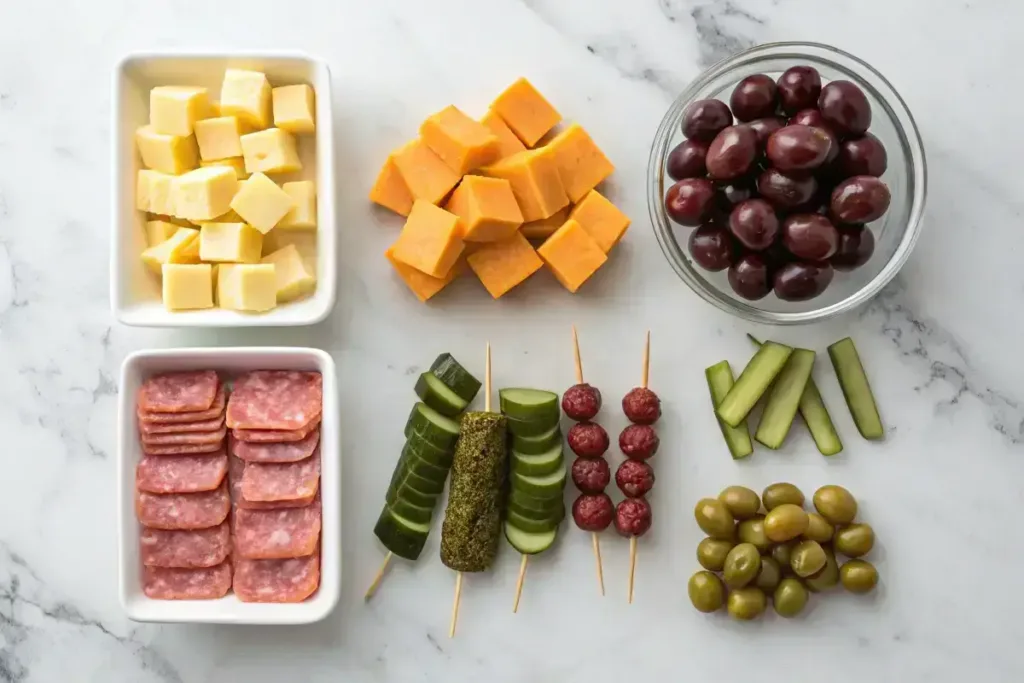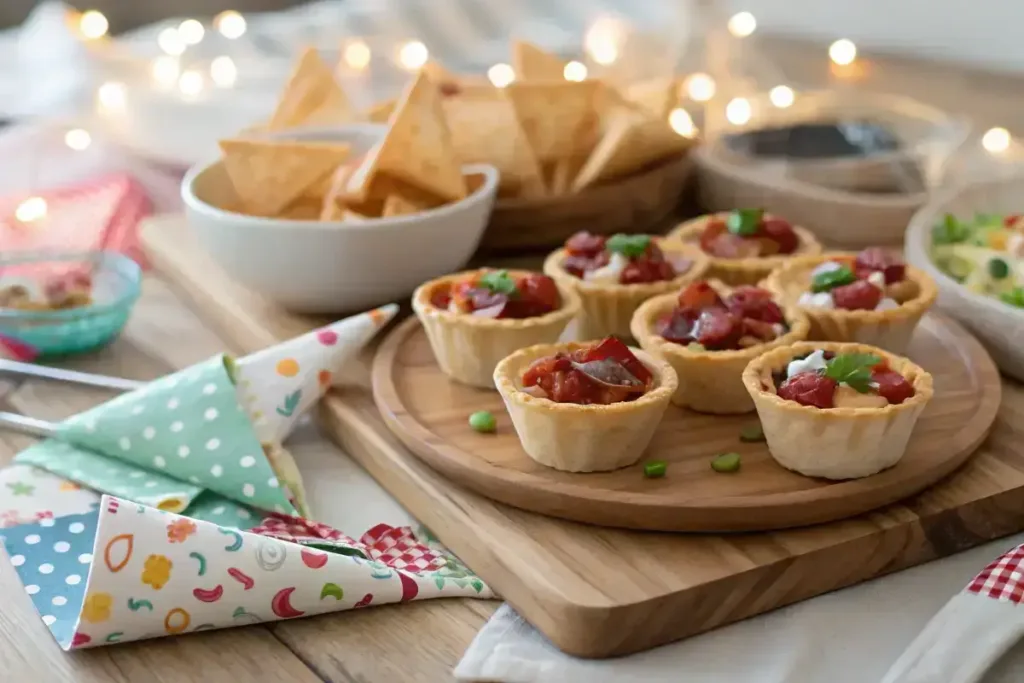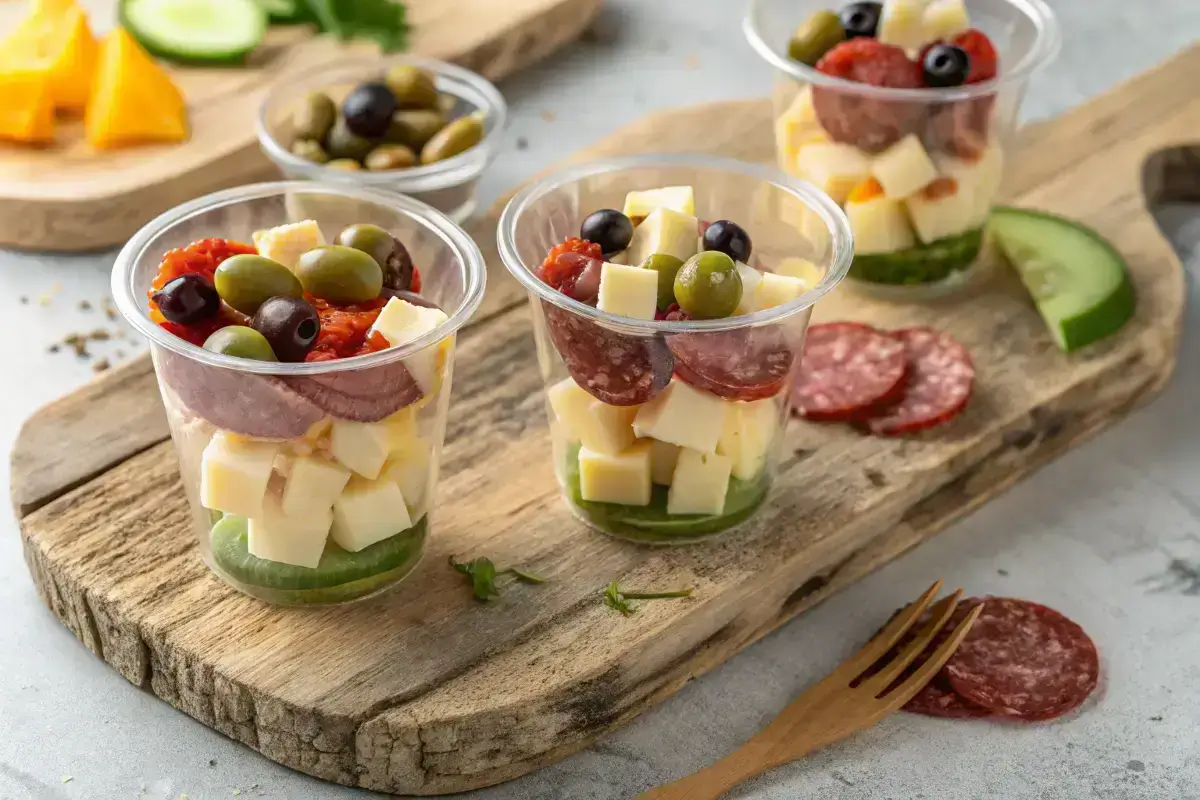Charcuterie cups are everything you love about a traditional board—made portable, stylish, and keto-friendly. Whether you’re hosting a dinner party, a game-day gathering, or a wine night with friends, these savory little snacks deliver on presentation and taste. In this article, we’ll explore how to build the perfect keto charcuterie cups, what ingredients to include (and avoid), how to prep ahead, and how the 3-3-3-3 rule helps create balance. Plus, you’ll get my personal tips as someone who found joy and healing through food—starting with these mini masterpieces.
In This Recipe
A Personal Take on Charcuterie Cups
Why I Fell in Love with Charcuterie Cups
At 49, I feel more alive than ever—and food finally feels like a friend, not an enemy. When I first started experimenting in my Oregon kitchen after switching to a keto lifestyle, I stumbled upon the idea of charcuterie cups while preparing for a neighborhood gathering. I was tired of guests hovering over one giant board. I wanted something cleaner, easier, and fun. So I grabbed clear plastic tumblers and started layering: salami rolls, cheese cubes, olives, and crunchy cucumber slices. By the end of the night, not a single cup remained.
The Charm of Individual Portions for Keto Entertaining
There’s something comforting about holding your own little cup of flavor. Guests don’t have to guess what’s keto-safe or worry about double-dipping. Each cup is a curated balance of protein, fat, and crunch—and there’s no need for utensils. It’s clean, cute, and completely practical.
From backyard barbecues to bridal showers, I’ve used these cups everywhere. They make keto hosting simple and approachable—even if your guests aren’t following a low-carb lifestyle. Plus, cleanup is a breeze, and the presentation always looks impressively intentional, even when you throw them together last-minute.
What Goes Into Perfect Keto Charcuterie Cups?
Keto-Friendly Ingredients You Can Count On
Building a keto charcuterie cup is all about balance—visually and nutritionally. Since the goal is to create low-carb, high-fat snacks, start with reliable staples. Think bite-sized cheese cubes like sharp cheddar, gouda, or pepper jack. Next, add cured meats: folded salami, rolled prosciutto, or mini pepperoni slices. You’ll want something briny like olives or pickles to cut the richness, and something crisp like cucumber rounds, celery sticks, or mini bell pepper strips.
Here’s a basic formula I follow (which ties into the 3-3-3-3 rule we’ll talk more about later):
- 3 cheeses: hard (like parmesan), soft (brie), and firm (cheddar)
- 3 meats: salami, turkey bites, prosciutto
- 3 accents: nuts, olives, pickles
- 3 dippers/crunch: cucumber spears, cheese crisps, pork rinds
Pro tip: Add a sprig of rosemary or a cherry tomato on a skewer for height—it looks elegant and adds a burst of color without sugar. You’ll find similar ingredients used in my 27 easy meal prep ideas, which shows just how versatile these components are.
Creative Combos That Impress Every Guest
What makes charcuterie cups shine is their mix-and-match personality. No two cups have to be the same. You can go rustic with smoked meats and sharp cheeses, or Mediterranean with feta cubes, olives, and roasted red peppers. Want it spicy? Add a small container of jalapeño cream cheese or a slice of spicy chorizo. Want something hearty? Toss in a boiled egg or a protein bagel chunk for a satisfying bite.
You can also theme them. I once did an “Italian keto” version with mozzarella pearls, salami, and a mini caprese skewer. Another time, a “breakfast charcuterie” cup included bacon, hard-boiled egg slices, and a wedge of my cottage cheese egg pizza crust. The possibilities are truly endless.
For each variation, I always make sure to stick to keto-safe options, keeping carbs under 5 grams per cup. This keeps the experience enjoyable for guests who track their macros.

How to Prep, Assemble & Store
Can I Make Charcuterie Cups the Night Before?
Absolutely—and honestly, it’s one of the reasons I love charcuterie cups so much. You can prepare most components up to 24 hours in advance, which makes party day completely stress-free. The key is smart layering and avoiding ingredients that get soggy.
Start by prepping your cheeses, meats, and veggies. Store each category in separate airtight containers. If you’re using ingredients with strong odors (like blue cheese or garlic-stuffed olives), keep them sealed individually to avoid flavor transfer. The day before your event, assemble your cups—but hold off on wet or oily ingredients until just before serving.
Layering matters:
- Place sturdier items like nuts or salami on the bottom.
- Middle layer: firm cheeses, folded meats, and crunchy veggies.
- Top layer: delicate garnishes like herbs or a drizzle of pesto.
If needed, cover each cup with plastic wrap or store them in a muffin tin covered in foil in the fridge. They’re portable, stackable, and hold up beautifully overnight.
Pro Tips for Freshness, Flavor, and Presentation
Here’s what I’ve learned from making hundreds of these cups: appearance counts—but so does taste. Always choose high-quality cheese and meat. A dry mozzarella stick won’t do you any favors. Go for block cheese and slice it fresh. It’s creamier, tastier, and looks better.
Consider investing in clear 9-ounce plastic cups—they offer just the right portion and let your ingredients shine. Bamboo toothpicks or mini skewers help structure the design and make it easy to grab items without fingers touching everything.
Want to wow your guests? Add a surprise layer like a mini deviled egg or a keto fat bomb in the bottom of the cup. They’ll find it halfway through and smile. That little delight goes a long way in making your food feel special.
Mistakes to Avoid When Making Charcuterie Cups
What NOT to Include in a Charcuterie Cup
Even the most beautiful charcuterie cup can fall flat if certain ingredients sneak in. Some are messy, some soggy, and others just aren’t keto-compliant. Here are five things I always avoid:
- Crackers or breadsticks – These spike carbs fast. Swap them for pork rinds, cheese crisps, or cucumber slices.
- Fruit – Grapes and apple slices might look pretty, but they’re full of sugar. Try olives, cherry tomatoes, or dill pickles for that sweet-sour pop.
- Runny dips – Sauces like hummus or honey mustard can leak and ruin your presentation. Stick to thicker, keto-friendly dips like whipped cream cheese or guacamole in mini cups.
- Overripe veggies – Soft cherry tomatoes or watery zucchini will create a mushy texture. Always choose firm, fresh produce.
- Too much of one item – Overloading on cheese or meat throws off balance and texture. Variety matters more than quantity.
These are the kinds of tips I also apply when designing family-style boards like the ones featured in my charcuterie board guide, where every item must earn its place.
The 3-3-3-3 Rule and How It Keeps Things Balanced
This simple rule is my go-to when assembling charcuterie cups—and it works every time. It helps create visual appeal, flavor variety, and a well-rounded keto snack. Here’s how it breaks down:
- 3 cheeses – Use a mix of textures: creamy brie, firm cheddar, aged gouda.
- 3 meats – Add variety with sliced salami, prosciutto twists, and turkey bites.
- 3 extras – Think olives, pickles, and almonds for crunch and acidity.
- 3 dippers/crunchy items – Cucumber spears, bell pepper strips, or pork rinds.
By sticking to the 3-3-3-3 structure, you not only stay within your carb goals—you also make the cup visually satisfying.
As a bonus, these ratios make it easy to scale for large events. Whether you’re making 4 cups or 40, you’ll know exactly what to buy and prep.

Frequently Asked Questions
What is the 3-3-3-3 rule for charcuterie?
The 3-3-3-3 rule is a simple and effective guideline to build balanced charcuterie cups or boards. It means including 3 types of cheese, 3 meats, 3 extras (like olives or nuts), and 3 crunchy elements (such as veggies or pork rinds). This ensures flavor variety and visual appeal without overcomplicating your shopping or prep.
What should go in a charcuterie cup?
A charcuterie cup should include a mix of keto-friendly ingredients like sliced meats (salami, prosciutto), cheeses (cheddar, gouda, brie), olives, pickles, nuts, and crisp veggies like cucumber or celery. Mini skewers help organize the contents and keep things clean and attractive.
Can I make charcuterie cups the night before?
Yes! You can prep charcuterie cups the night before your event. Assemble them with dry and firm ingredients first and add anything juicy or oily (like pickles or pesto) closer to serving time. Wrap each cup or store in a muffin tin with foil to keep fresh in the fridge overnight.
What are 5 things to avoid on a charcuterie board?
Avoid crackers and bread (too high in carbs), sugary fruits, runny dips, soggy vegetables, and ingredient overload. Too many similar textures or overpowering flavors can make the board feel heavy or unbalanced. Stick with keto-friendly options and variety in taste and texture.
Conclusion
Charcuterie cups are more than just trendy—they’re a fun, creative, and keto-friendly way to entertain without stress. Whether you’re feeding four or forty, these single-serve appetizers bring color, variety, and balance to any table. As someone who’s found joy and health through keto, I love creating moments where food feels good again—for everyone.
Want to discover more low-carb ideas? Don’t miss my keto cottage cheese egg pizza crust or these easy keto breakfasts that make mornings a breeze.
